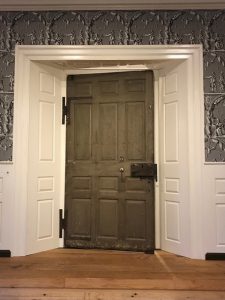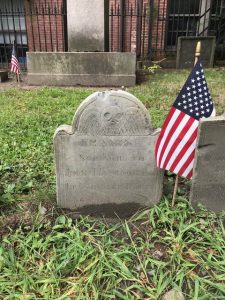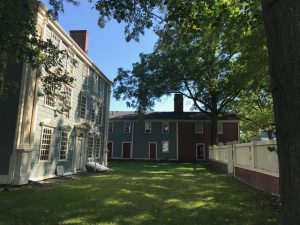 The interior side of the Hancock Mansion’s front door, preserved in the Massachusetts Old Statehouse. This is the side that Cato Hancock would have known well.
The interior side of the Hancock Mansion’s front door, preserved in the Massachusetts Old Statehouse. This is the side that Cato Hancock would have known well.
I truly went down a rabbit hole recently, and all the credit goes to NEHGS’s Chief Genealogist, David Allen Lambert. He recently reported in Vita Brevis that his second academic sabbatical was spent transcribing the 1800 “Taking Books” (tax records) for Suffolk County, Massachusetts. I commented then that I looked forward to checking out this new database, and recently I got around to doing so.
I’d already discovered my ancestor, George Athearn, in Boston city directories for 1798, 1800, 1803, 1805, 1806, and 1807, but it was still fun to check out his entry in the Taking Books. I noted wryly that his surname and that of his business partner, Stephen Fales, were both misspelled; additional notes were “Merch[an]t: ½ Store on Spears W[harf], partners w[ith] Fails, Large Ho[use]” with real estate valued at $3,000.
There was so much good information in this record that I decided to check out some other folks. Forgetting that the famous John Hancock had died a few years earlier, I searched for him and found two John Hancocks: one was the governor’s namesake nephew (real estate valued at $4,000) and the other was listed as “servant to Robert Treat Payne” [sic], another signer of the Declaration of Independence. My eye was then caught by an entry for Cato Hancock, “black man.” My curiosity was piqued.
 Grave marker for Frank, “servant” of John Hancock, who is buried just outside the Hancock Family tomb at Boston’s Granary Burying Ground.
Grave marker for Frank, “servant” of John Hancock, who is buried just outside the Hancock Family tomb at Boston’s Granary Burying Ground.
Cato Hancock also appeared in the 1810 Boston census as head of a household with 16 persons of color on Rainsford Lane, and in the Boston directories of 1813 and 1816 at the same location, listed as “African.” I found two marriage records for Cato Hancock: he married Phebe Baker on 25 November 1789,[1] and Nancy Faddy on 3 July 1791. Presumably Phebe died between those dates, but Nancy apparently lived until 1815 and was buried in Boston’s South Burying Ground. Cato himself died in 1817 and was buried at the Central Burying Ground on Boston Common.
How did Cato acquire the surname Hancock? Like many free men of color, he adopted the surname of his former slave masters: merchant Thomas Hancock and his famous nephew and heir, John. A letter John Hancock sent his brother Ebenezer from London in December 1760 mentions Cato, as well as other Hancock “servants.” “How is Molly, & how does Cato behave. Is Agniss a Breeding. Is Prince as gouty as ever, & Hannibal as peevish as formerly[;] tell him I think of him, as he was the last of the family on the Wharf.”
This last comment hints at dynamics within slave-owning households that are hard for twenty-first century Americans to understand. John Hancock reputedly brought a cap and a French horn home as gifts for Cato, and when Thomas Hancock died in 1764, small legacies were left to each of his slaves, with Cato promised manumission when he turned thirty.[2] When John Hancock’s “servant” Frank died in 1771, he was buried with a marker just outside the Hancock family vault in the Granary Burying Ground. While some White masters expressed bonds of affection for their Black “servants,” it’s hard to imagine how those feelings could have been honestly reciprocated when other bonds holding them to these families were made of iron.
When John Hancock’s “servant” Frank died in 1771, he was buried with a marker just outside the Hancock family vault in the Granary Burying Ground.
I found more records for Cato Hancock in Medford, Massachusetts, indicating that he’d paid poll and modest real estate taxes. Could this be the same Cato Hancock, given the different location? And could African Americans even vote then? The answer to both questions turned out to be “yes,” based on other names in those tax rolls, including one that appeared adjacent to Cato Hancock’s more than once: Prince Hall.
Prince Hall founded the first lodge of African American Masons in 1775, and there are still lodges throughout the country bearing his name. He also fought in the Revolutionary War,[3] and later became a major force in advocating for education and emancipation of African Americans. In 1788 he led a petition for the return of three free Black men who were abducted as they labored onboard a ship in Boston Harbor and then taken to the Caribbean to be sold as slaves. John Hancock and the French consul worked for their release, and the three men arrived home in Boston on 29 July of that year. The three free Black men had also self-advocated upon arriving in the Caribbean, using their Masonic connections. Due in large part to outrage over this incident, the Massachusetts legislature outlawed the slave trade in their state in March 1788.
One of those three captives was Wenham Cary, who also appeared on the Medford tax rolls of 1778 and 1779, and was the “William Carey” listed in 1778 military documents along with Primus Freeman (another free African American) and Prince Hall as privates from Medford.[4] Wenham was, no doubt, connected with Colonel Richard Cary and his brother Samuel, who appear in the Medford tax rolls beginning in 1777. According to the historic Royall House’s website, Col. Cary (an aide de camp to George Washington in 1776) lived in the house following confiscation from its loyalist owner.[5]
When I decided to check out George “Athern” in the 1800 Boston Taking Books, I never imagined that I would end up down such a deep rabbit hole! While the relationships Cato Hancock, Prince Hall, and Wenham Cary established between themselves are paramount, strangely enough my ancestor also shared bridges between them. Letters between George Athearn’s father and John Hancock suggest that the senior Athearn visited the Hancock Mansion on Beacon Hill. Did Cato Hancock greet him at the door? And in 1807, George’s oldest son married Lydia Cary, a first cousin of Richard and Samuel Cary. Did Wenham Cary ever handle correspondence between those branches of the Cary family? One can only imagine…
Notes
[1] In the column that lists the surname of each groom for quick scanning, the scribe started to write “Hancock,” but after writing the first letter, wrote “Casto” [sic] instead … indicating that he didn’t consider Cato to be a real Hancock.
[2] This letter can be yours if you have $29,000 burning a hole in your pocket!
[3] Cato Hancock enlisted at Medford on 7 April 1777 and was discharged 20 March 1779.
[4] Wenham re-enlisted in Boston on 22 July 1780, with his name listed as Windham. In all records for both “William” and “Windham,” he is described as 5’ 4” tall. His age in 1778 was listed as 35, and his age in 1780 was listed as 34. Details from Massachusetts Soldiers and Sailors in the Revolutionary War, Vol. 3.
[5] It seems doubtful that this man is the same individual as an enslaved man named Wenham listed in the 1741 estate inventory of Richard and Samuel Cary’s grandfather. That Wenham would have been at least in his mid-fifties during the war, and his mid-sixties by 1788.
Share this:

About Pamela Athearn Filbert
Pamela Athearn Filbert was born in Berkeley, California, but considers herself a “native Oregonian born in exile,” since her maternal great-great-grandparents arrived via the Oregon Trail, and she herself moved to Oregon well before her second birthday. She met her husband (an actual native Oregonian whose parents lived two blocks from hers in Berkeley) in London, England. She holds a B.A. from the University of Oregon, and has worked as a newsletter and book editor in New York City and Salem, Oregon; she was most recently the college and career program coordinator at her local high school.View all posts by Pamela Athearn Filbert →
